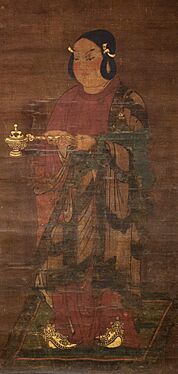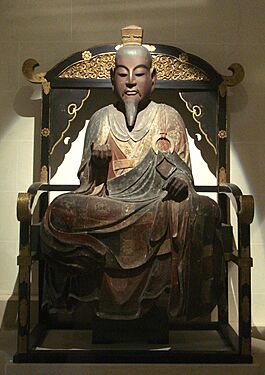Prince Shōtoku facts for kids
Quick facts for kids Prince Shōtoku |
|
|---|---|
| Prince of Yamato | |

Prince Shōtoku with younger brother (left: Prince Eguri) and first son (right: Prince Yamashiro)
|
|
| Regent of Yamato | |
| Regency | 593 - 622 |
| Born | February 7, 574 |
| Died | April 8, 622 (aged 48) |
| Spouse | Uji no Shitsukahi Tojiko no Iratsume |
| Issue | Prince Yamashiro |
| House | Yamato |
| Father | Emperor Yōmei |
| Mother | Anahobe no Hashihito |
Prince Shōtoku (聖徳太子, Shōtoku Taishi, February 7, 574 – April 8, 622) was a very important leader and politician in ancient Japan. He lived during the Asuka period and served as a regent (a person who rules for a monarch who is too young or unable to rule). He worked for Empress Suiko, who was his aunt.
Prince Shōtoku was the son of Emperor Yōmei. His family was connected to the powerful Soga clan. He helped defeat the rival Mononobe clan. Most of what we know about Prince Shōtoku comes from an old Japanese book called the Nihon Shoki. He is famous for making the government more modern and for helping Buddhism grow in Japan. Over time, people began to admire Prince Shōtoku greatly. They believed he protected Japan, the Imperial Family, and Buddhism. Many important religious leaders later said they were inspired by him.
Contents
Prince Shōtoku: A Great Leader of Ancient Japan
Who Was Prince Shōtoku?
Prince Shōtoku was born on February 7, 574. He is known by several names, including Prince Umayado and Prince Kamitsumiya. He became a regent in 593, which means he helped rule Japan for his aunt, Empress Suiko. He was a very smart and spiritual leader.
Modernizing the Government
Prince Shōtoku wanted to make Japan's government stronger and more organized. In 603, he created the Twelve Level Cap and Rank System. This system gave government officials different ranks based on their skills, not just their family name. This was a big step towards a fairer government.
He is also famous for writing the seventeen-article constitution. This was a set of moral rules and guidelines for government officials and the people. It focused on ideas like harmony, respect, and following the emperor's orders.
Spreading Buddhism in Japan
Prince Shōtoku was a very strong believer in Buddhism. He worked hard to spread its teachings across Japan. He even wrote commentaries on important Buddhist scriptures. These writings are considered some of the first Japanese texts ever written.
He led a huge project to build Buddhist temples. One of the most famous is Shitennō-ji in Osaka. He built this temple after winning a battle against the Mononobe clan. Another famous temple linked to him is Hōryū-ji in Yamato Province. Even though he promoted Buddhism, he also respected Japan's traditional religion, Shinto.
Japan's Name and International Relations
Prince Shōtoku also played a role in how Japan was seen by other countries. He sent a letter to the Emperor of Sui in China. In this letter, he referred to Japan as the "land of the rising sun." This is the first time this famous name for Japan was used in writing. It showed that Japan saw itself as an equal to China.
Famous Stories and Legends
There are many interesting stories about Prince Shōtoku. One legend says that he met a starving beggar who was actually Bodhidharma, a famous Buddhist monk. Prince Shōtoku showed kindness to the beggar, giving him food and his own purple cloak. When the beggar later seemed to die, Shōtoku ordered him to be buried.
However, Shōtoku later felt the man was special. He sent someone to check the grave and found that the body was gone, and only his purple cloak was left. This made people realize that Prince Shōtoku was very wise and could recognize a true sage. This story is connected to the Daruma-ji temple in Ōji, Nara.
Why So Many Names?
Prince Shōtoku is known by several names. His real name was Prince Umayado, which means "the prince of the stable door." This is because he was born in front of a stable. He was also called Toyosatomimi or Kamitsumiyaō. The name "Prince Shōtoku" became popular much later, after his death.
His Lasting Impact
Prince Shōtoku's influence is still seen in Japan today. Many schools and universities are named after him. His portrait has also appeared on several Japanese banknotes, including the 10,000 yen bill. This shows how important he is in Japanese history and culture.
Gallery
Painting
-
Painting of Prince Shōtoku with two attendants. Colors on silk, Kamakura Period, 13th century
-
Painting of Shōtoku and two attendants, from Kakurin-ji temple in Kakogawa. Hyōgo Prefecture
-
Silk painting of Shōtoku at age sixteen, Nanboku-chō Period, 14th century
-
Drawing of Shōtoku by Kikuchi Yōsai (1781–1878)
Sculpture
-
Shōtoku as a bodhisattva at Asuka-dera temple
-
Sculpture of Shōtoku from Hōryū-ji temple
See also
 In Spanish: Shōtoku para niños
In Spanish: Shōtoku para niños
- Asuka-dera
- Jōgū Shōtoku Hōō Teisetsu, biography
- Kokki
- Sangyō Gisho
- Tennōki
- Historical Sites of Prince Shōtoku














